class: center, middle, inverse, title-slide .title[ # Control Flow ] .subtitle[ ## The building blocks of algorithms ] .author[ ### Guillaume Falmagne ] .date[ ### <br> Sept. 16th, 2024 ] --- # A bit of terminal magic (bash) Doing things in the terminal / command line is clearer than with GUI. GUI's can do things you have no idea of... - What directory am I in? `pwd` - Changing directory: - To a certain path: `cd [path_of_directory]` - To one level above: `cd ..` - To two levels above: `cd ../..` - To directory I was in before this one: `cd -` - Auto-complete a path or a command (**extremely useful!**): tabulation - Read directory content: `ls` or `ls -a` - Copy a file: `cp [path_source] [path_destination]`. Move a file: `mv [source] [destination]` - Put whatever here: wildcard `*`. Examples: `ls ./my_path/*.py` or `ls ./my_path/basename_*` - Look for a word in all files of this directory: `grep -rn "your_word"` --- # Recap .pull-left[ - R and python are interpreted languages, sometimes used interactively - In R, objects have different **classes**: vectors, lists, dataframes... These objects can be numbers, strings, logical, ... - In python, variables do not need to be assigned a **type** - We can store and use these variables by assigning them **names** (`=`, or `<-` in R) - All objects can be **indexed**, allowing us to access parts of the objects - **Functions** can apply the same code to different arguments without rewriting the code ] -- .pull-right[ ### Version control - **Git** is a version control program that tracks and stores the changes of all files in a directory - We use git to have an annotated **history of all the changes** we did to script files - Git can also maintain different "states" of the files in a directory. These are stored in **branches** - Different versions can be merged, either automatically or manually, and this allows for **asynchronous collaboration** ] --- # Lectures can not teach you to draw the owl! .center[ 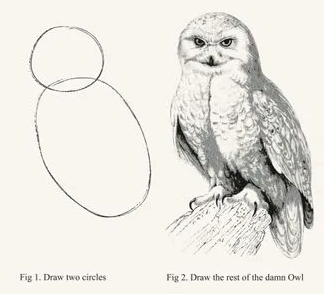 ] ### General tips for precepts .pull-left[  ] .pull-left[ Also, **read the error and warning messages**! More useful than "user terms and conditions"... Skim to text that seems to point to what you did wrong ] --- # The basic elements of an algorithm - Variables - Storing values in objects to use later: ``` r x = 1 y <- 2 # only in R, would be y = 2 in Python y = 2 # Python and R x <- x + y # only in R, would be x = x + y in Python x * 4 ``` ``` ## [1] 12 ``` - Logical comparisons ``` r x > y ``` ``` ## [1] TRUE ``` Coming next: - Conditionals - Loops --- # Examples of high level algorithms .left-column60[ 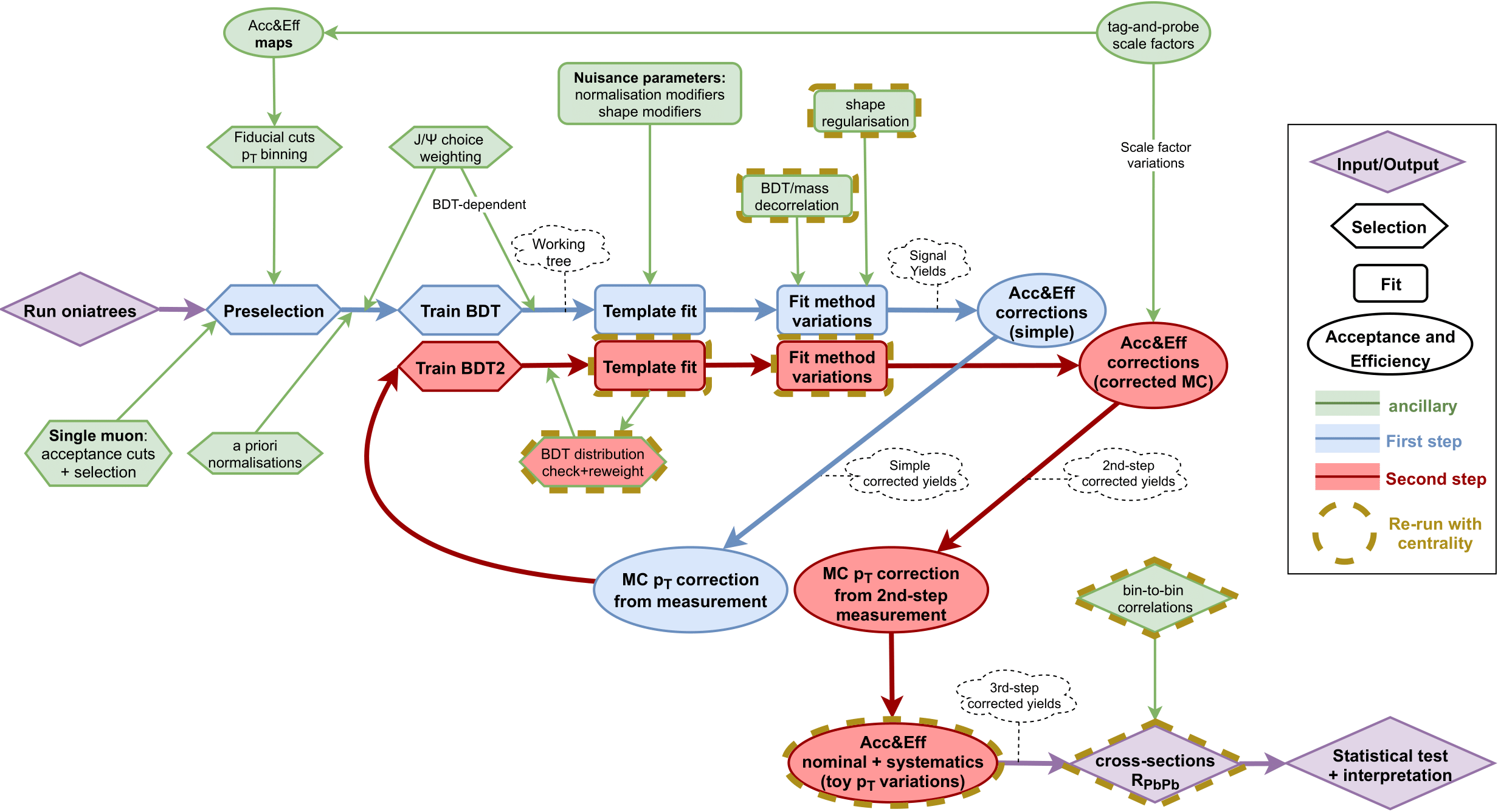 .ref[Falmagne G., The Bc+ meson in heavy-ion collisions with the CMS detector (2022)] ] .right-column60[ 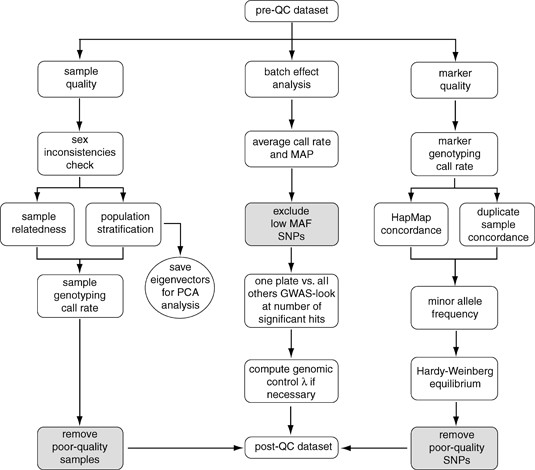 .ref[Turner, S. et al. Quality control procedures for genome-wide association studies. Curr. Protoc. Hum. Genet. Chapter 1, Unit1.19 (2011)] ] --- class: inverse, center, middle # Logical operators --- # Logical operators, booleans - Logical operators are used to perform **comparisons**, tests and data selection. - They return logical values (a.k.a **booleans**): `TRUE` or `FALSE` in R, `True` or `False` in Python. - Essential for control flow and data filtering. --- # Single Logical Operators ## Single Comparison Operators - `>` : Greater than - `<` : Less than - `>=` : Greater than or equal to - `<=` : Less than or equal to - `==` : Equal to (doubled because we use `=` for assignment) - `!=` : Not equal to .pull-left[ #### R ``` r x <- 5 y <- 7 x > y ``` ``` ## [1] FALSE ``` ] .pull-right[ #### Python ``` python x = 5 y = 7 x > y ``` ``` ## False ``` ] --- # Comparing Floating-Point Numbers .left-column60[ 1. **Avoid Exact Equality:** - Floating-point arithmetic can lead to tiny differences. - Instead of `x == y`, use `abs(x - y) < epsilon`. 2. **Specify Tolerance:** - Define a small `epsilon` value to handle small differences. 3. **Use Functions:** - `all.equal(x, y)` (R) or `np.is_close(x, y)` (Python) considers small differences. - `identical(x, y)` (R) checks for exact equality. - `x is y` in Python checks if `x` and `y` point to the same address! *Lesson*: when you can use integers rather than floating point numbers, these problems disappear! ] .right-column60[ ### Examples in R ``` r x <- 0.1 + 0.2 y <- 0.3 x == y ``` ``` ## [1] FALSE ``` ``` r epsilon <- 1e-10 abs(x - y) < epsilon ``` ``` ## [1] TRUE ``` ``` r all.equal(x, y) ``` ``` ## [1] TRUE ``` ] --- # "Eager" operators ### **`|` (OR Operator)**, **`&` (AND Operator)** The single-character operators `&` and `|` perform element-wise logical AND/OR between two vectors or scalars. It returns a vector of the same length as the inputs, where each element is the logical AND/OR of pairs of elements at that index in the input vectors. ``` r x <- c(TRUE, FALSE, TRUE) y <- c(TRUE, TRUE, FALSE) x | y ``` ``` ## [1] TRUE TRUE TRUE ``` ``` r x & y ``` ``` ## [1] TRUE FALSE FALSE ``` * In Python: same behavior between numpy arrays. But more generally: `&` and `|` are **bitwise operators** (comparing each bit of the objects one-to-one). * Eager means that **both sides are always evaluated**, even when unnecessary: `(1 == 2) & (1 == 1)` --- # Short-circuit evaluation (R) ### **`||` (OR Operator)**, **`&&` (AND Operator)** The double `&&` and `||` operators performs short-circuit evaluation: It evaluates the left-hand side expression first and only evaluates the right-hand side expression if the the information is not sufficient to determine the output. .pull-left[ ``` r x <- 5 x > 10 && z < 7 # z is undefined! ``` ``` ## [1] FALSE ``` ``` r y <- 7 x > 2 || y > 10 ``` ``` ## [1] TRUE ``` ] .pull-right[ 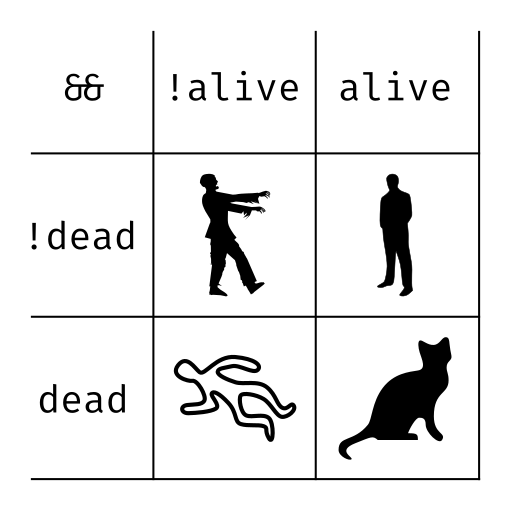 ] --- # Short-circuit evaluation (Python) .pull-left[ ### `and` and `or` in standard Python In Python, `and` and `or` do similar short-circuiting, but are more general. e.g. `X or Y` evaluates as `if X is False, then Y, else X` ``` python import numpy as np 1 or False ``` ``` ## 1 ``` ``` python 1 and np.array([True]) ``` ``` ## array([ True]) ``` ``` python 0 and np.array([True]) ``` ``` ## 0 ``` ] .pull-right[ ### `np.logical_and()` in numpy But for numpy arrays, the best way is `np.logical_and(x, y)` and `np.logical_or(x, y)` ``` python x = np.array([False, True, False]) y = np.array([True, True, False]) np.logical_and(x, y) ``` ``` ## array([False, True, False]) ``` ``` python np.logical_or(x, y) ``` ``` ## array([ True, True, False]) ``` ] --- # Negation operators .pull-left[ - **R**: `!` is a negation operator, it inverts logical values ``` r bool_vec = c(FALSE, TRUE, TRUE) bool_vec ``` ``` ## [1] FALSE TRUE TRUE ``` ``` r !bool_vec ``` ``` ## [1] TRUE FALSE FALSE ``` .center[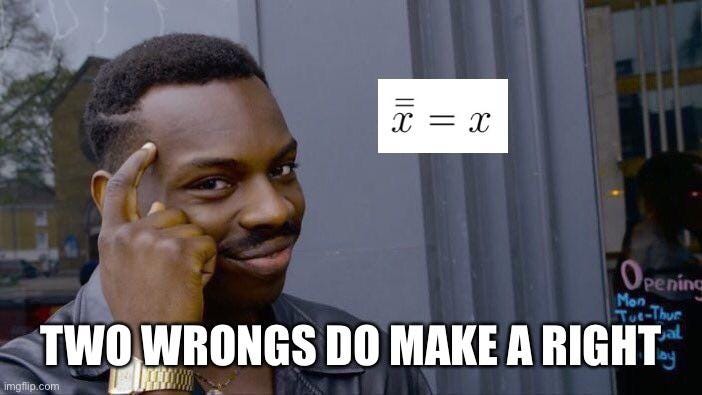] ] .pull-right[ - Standard Python: `not` is the negation ``` python not True ``` ``` ## False ``` - `np.logical_not` for numpy arrays ``` python bool_vec = np.array([False, True, True]) np.logical_not(bool_vec) ``` ``` ## array([ True, False, False]) ``` ] --- # Logics on boolean vectors: `any`, `all` - How to evaluate vectors of boolean variables? Some combination of `any`, `all` or `!` often suffices .pull-left[ ``` r any(bool_vec) # Is any value true? ``` ``` ## [1] TRUE ``` ``` r all(bool_vec) # Are all values true? ``` ``` ## [1] FALSE ``` ] .pull-right[ ``` r any(!bool_vec) # Is any value false? ``` ``` ## [1] TRUE ``` ``` r all(!bool_vec) # Are all values false? ``` ``` ## [1] FALSE ``` ] <br> - In Python: same with `np.all(x)`, `np.any(x)`, `np.logical_not(x)` --- class: inverse, center, middle # Conditionals --- # if statements (R) .pull-left[ ### Basic structure ```r if (condition) {true_action} if (condition) {true_action} else {false_action} ``` Example in function: ``` r grade <- function(x) { if (x > 90) { "A" } else if (x > 80) { "B" } else if (x > 70) { "C" } else { "F" } } grade(74); grade(98) ``` ``` ## [1] "C" ``` ``` ## [1] "A" ``` ] .pull-right[ ### Common errors ```r if ("x") 1 #> Error in if ("x") 1: # argument is not interpretable as logical if (logical()) 1 #> Error in if (logical()) 1: # argument is of length zero if (NA) 1 #> Error in if (NA) 1: # missing value where TRUE/FALSE needed if (c(TRUE, FALSE)) 1 #> Warning in if (c(TRUE, FALSE)) 1: #> the condition has length > 1 and only the #> first element will be used ## [1] 1 ``` ] --- # if statements (Python) .pull-left[ ### Basic structure ```python if condition: x = 2 elif condition2: x = 3 else: x = -1 ``` ### Example ``` python def grade(x): if x > 90: return "A" elif x > 80: return "B" elif x > 70: return "C" else: return "F" grade(74); grade(98) ``` ``` ## 'C' ## 'A' ``` ] .pull-right[ The syntax is indentation based! Also possible in a "one-liner": ```python true_action if condition else false_action ```  ] --- # Vectorized if .pull-left[ ### R ```r ifelse(logical_vector, true_object, false_object) ``` ``` r x <- 1:5 x %% 2 ``` ``` ## [1] 1 0 1 0 1 ``` ``` r x %% 2 == 0 ``` ``` ## [1] FALSE TRUE FALSE TRUE FALSE ``` ``` r ifelse(x %% 2 == 0, "even", "odd") ``` ``` ## [1] "odd" "even" "odd" "even" "odd" ``` ] .pull-right[ ### Python ```python np.where(logical_vector, true_object, false_object) ``` ``` python x = np.arange(1, 6) x % 2 ``` ``` ## array([1, 0, 1, 0, 1]) ``` ``` python x % 2 == 0 ``` ``` ## array([False, True, False, True, False]) ``` ``` python np.where(x % 2 == 0, "even", "odd") ``` ``` ## array(['odd', 'even', 'odd', 'even', 'odd'], dtype='<U4') ``` `where` also gives list of indices where cond is True ``` python np.where(x > 3)[0] ``` ``` ## array([3, 4]) ``` ] --- class: inverse, center, middle # Loops --- # Loop = repeated operations .pull-left[ ### Structure in R ```r for (item in vector) perform_action ``` ``` r for (i in 1:3) { print(i) } ``` ``` ## [1] 1 ## [1] 2 ## [1] 3 ``` ] .pull-right[ ### Structure in Python .pull-left[ ```python for item in list: perform_action ``` ``` python for i in range(3): print(i+1) ``` ``` ## 1 ## 2 ## 3 ``` ] .pull-right[ 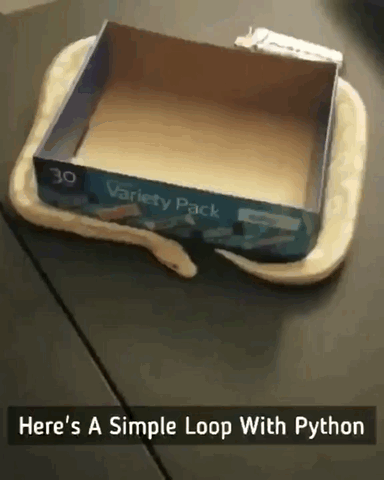 ] - Python does **list comprehension** with for loops! ``` python double = [2*i for i in range(3)] double ``` ``` ## [0, 2, 4] ``` ] --- # Structure of a useful loop - A typical usage: at each iteration, compute a function on given element, then store the results of a calculation in a new vector - Good practice: allocate this vector before the loop .pull-left[ #### Typical usage ```r n <- 10 # length of results results <- numeric(n) # or list() or character(n) for(i in 1:n){ results[i] <- some_function(i) } ``` ] .pull-right[ #### Example ``` r n <- 5 grades <- floor(runif(n, 70, 100)) grades ``` ``` ## [1] 97 98 78 94 89 ``` ``` r letter_grades = character(n) for(g in 1:n){ letter_grades[g] <- grade(grades[g]) } letter_grades ``` ``` ## [1] "A" "A" "C" "A" "B" ``` ] --- # Common mistake ### Not indexing the `results` object ``` r n <- 5 grades ``` ``` ## [1] 97 98 78 94 89 ``` .pull-left[ **Good**: ``` r letter_grades = character(n) for(g in 1:n){ letter_grades[g] <- grade(grades[g]) } letter_grades ``` ``` ## [1] "A" "A" "C" "A" "B" ``` ] .pull-right[ **Bad**: ``` r letter_grades = character(n) for(g in 1:n){ * letter_grades <- grade(grades[g]) } letter_grades ``` ``` ## [1] "B" ``` Problem: at each iteration, `letter_grades` is fully replaced with a single grade ] --- # Access the index or the actual element? When filling a vector with a loop from another vector, you might need to access either the index or the actual element of the vector. .pull-left[ #### `seq_along` in R ``` r means <- c(1, 50, 20) out <- vector("list", length(means)) # seq_along is preferred to 1:length(means) for (i in seq_along(means)) { out[[i]] <- rnorm(4, means[[i]]) } out ``` ``` ## [[1]] ## [1] 1.0478847 -0.1045994 1.5390238 1.5802063 ## ## [[2]] ## [1] 49.34250 51.55490 48.81236 50.15181 ## ## [[3]] ## [1] 18.91387 21.61337 20.03563 21.31496 ``` ] .pull-right[ #### `enumerate` in Python ``` python mylist = ['a', 'b', 'c'] for i, e in enumerate(mylist): print('at index', i, 'find element', e) ``` ``` ## at index 0 find element a ## at index 1 find element b ## at index 2 find element c ``` ] --- # Next/continue and break - `next` (in R) or `continue` (in Python) exits the current iteration. - `break` exits the entire loop. ``` r for (i in 1:10) { if (i < 3) # no '{' is needed when there is only one line of code inside the 'if' next # replace by "continue" in Python print(i) if (i >= 5) break } ``` ``` ## [1] 3 ## [1] 4 ## [1] 5 ``` --- # Other, less used, loop functions .pull-left[ ```r # performs action while condition is TRUE. while(condition) action # repeats action forever # (i.e. until it encounters break). repeat(action) ``` - You can rewrite any `for` loop to use `while` instead, and any `while` loop to use `repeat` - `while` is more flexible than `for`, and `repeat` is more flexible than `while`. But strive to use the least-flexible option (`for`) - `while` can be dangerous: risk of **infinite loops** if `while` condition always stays true - `repeat` embraces the infinite loop... bad practice ] .pull-right[ ```python while condition: action # repeat does not exist in Python ``` 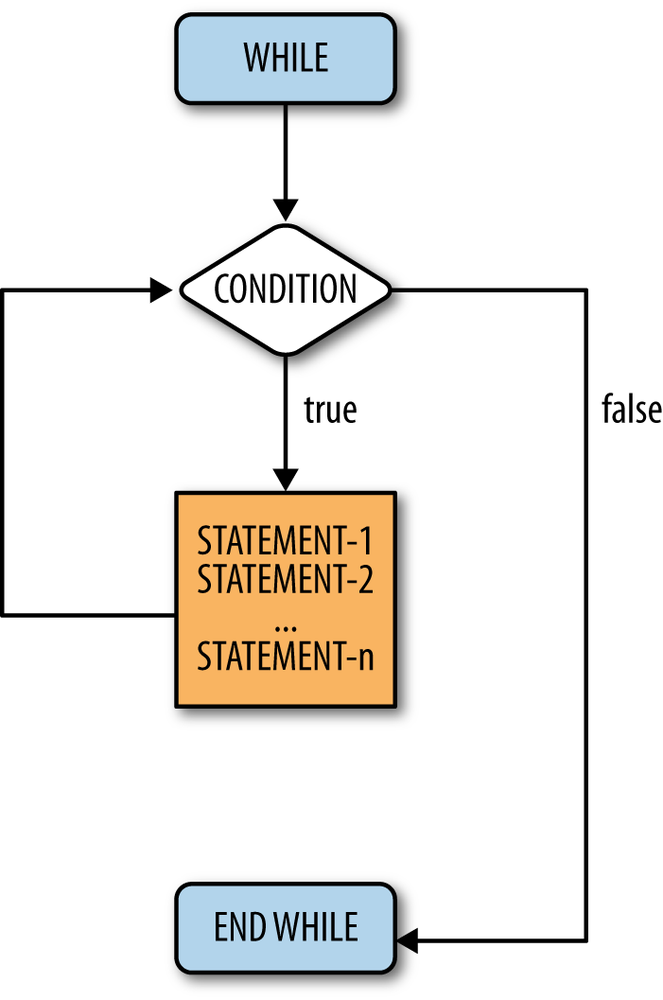 ]